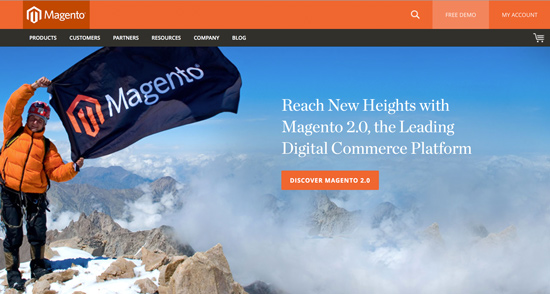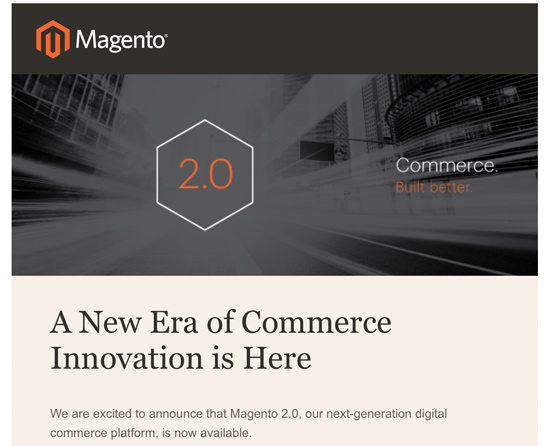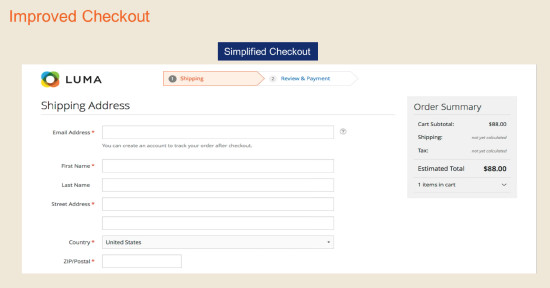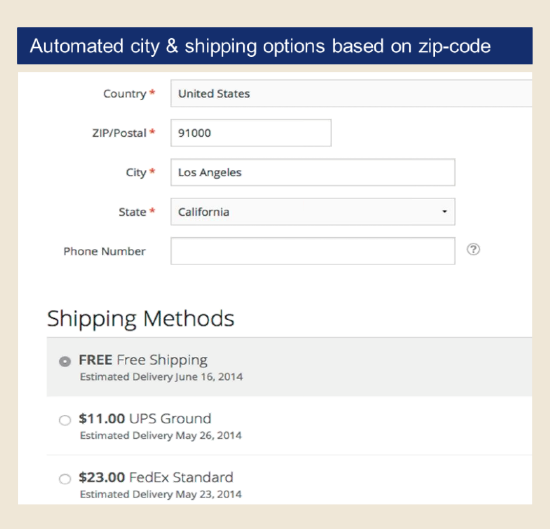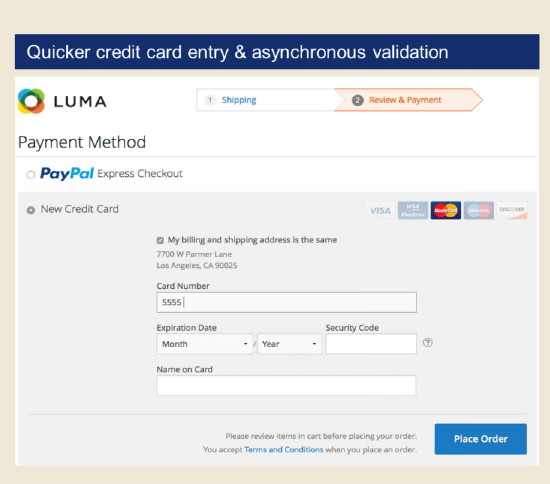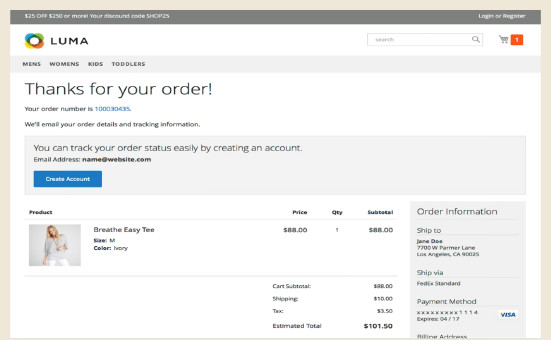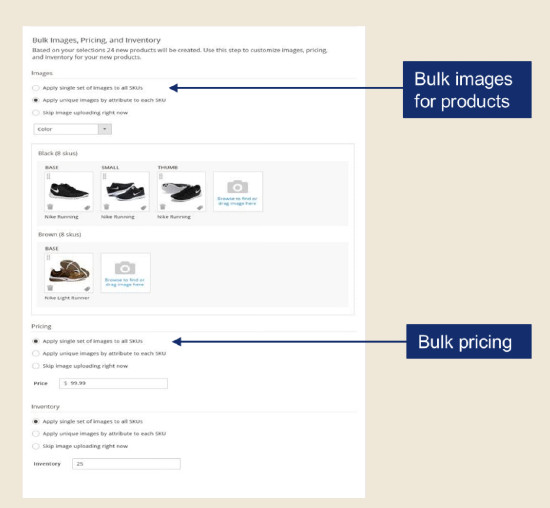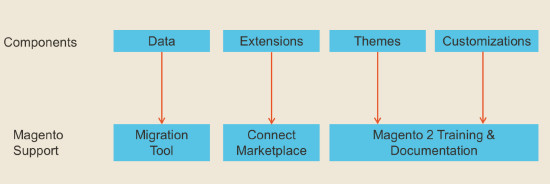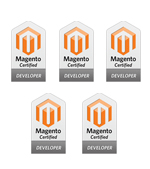Upgrade to Magento 2.4
Magento 2.1, 2.2 or 2.3 –> Magento 2.4 Upgrades
If you need help upgrading your Magento 2.x site to the latest version of the Magento 2.4 platform, we can help.
From design migration, customer records, extensions and more, we have extensive experience in helping merchants move to Magento 2.4.
- Free, No Obligation Consultation
- Boulder, CO-based Magento certified programmers
- Extensive Magento 1.x and 2.x experience
- Magento Certified Partner since 2012
- Developers who care. Code that works.
- 18,600+ Projects Completed since 2002
Call or Text Now: 303.473.4400
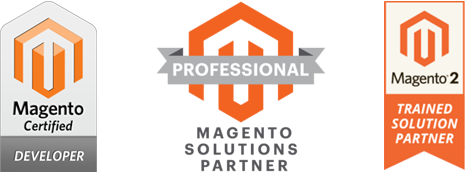
Certified Magento Developers

Our Approach to Upgrading to Magento 2.4:
Upgrading is critical for security. But upgrading Magento can be painful, too: a lot of things can break.
Our approach is simple:
• We’ll download your site onto a test server
• We’ll run an upgrade script on your site
• We’ll run automated and manual tests on the test site
• We’ll evaluate the site with you and determine a plan for upgrading
In some cases, there may be only minor issues with the upgrade, and we can schedule a time to upgrade the live site.
In other cases, there may be extension conflicts that require us to download and update existing extensions. It’s also possible that design features or additional customizations or integrations need to be examined and fixed.
In rare cases, we’ve seen database issues that require us to do a fresh installation of Magento 2.4, and then migrate products, content and design files a different way.
Our goal: we want to make it as easy as possible for your site to be secure. As new versions of Magento come out, it’s important to keep up to date.
We’re here to help. What sets us apart are years of Magento development and upgrade experience. We’ve built extensions that have been incorporated directly into the Magento core code. We’re based in Boulder, Colorado and know how to keep your site running.
Bonus: With any upgrade, we’re including at no additional charge an artificial intelligence extension that provides personalized recommendations to your end users. One of our clients saw a $50.02 increase in order size and a 40.5% increase in overall sales using the tool. (Ask us about this; the extension will be free, but you’ll need to pay for the machine learning processing time.)
Company Headquarters
5353 Manhattan Circle Suite 103 Boulder, CO 80303
303.473.4400 / Toll Free: 888.772.0777
Customer Paradigm’s Free No Obligation Consultation
PROJECTS
DEVELOPMENT HOURS
Since 2002, we've completed more than 18,600+ successful web development and marketing projects for our customers.
U.S. Based
Based in Boulder, Colorado. We speak English, work during normal US business hours and respond quickly.
Certified Magento Developers
We have worked on hundreds of eCommerce systems that process tens of thousands of transactions per day. We know the best practices for working on high-volume, live production systems (as well as low-volume basic Magento systems).
Low Prices for Magento Developers
Our prices are low, but our quality and customer service is high. Unlike other web development agencies we also offer firm quotes for your project, so you know what to expect when you receive your bill.
Small Projects Are Okay
We work with small 1-2 person companies, as well as some of the largest corporations in the world. We know you might want to test out our team first, before you commit to a larger project. And we’re okay with that. We have no minimums for working with us.
Bug Free Code
Our programmers write bug-free code that works! We have a dedicated team of testers to ensure that the delivered Magento Programming works as requested.
Direct Access to a Magento Developer
You’ll get the name, email address and direct phone number of your Project Manager and Developer that is in charge of your Magento eCommerce project. Our Project Managers keep you apprised of your project’s budget and progress, and also ensure that your needs as a client are met exactly.
We Answer the Phone & Emails
We know that this shouldn’t be something we have to mention, but we do pride ourselves on our ability to have a real person answer the phone during our business hours, and we make sure to respond to all email requests promptly.
Open Office Format
We work together in an open-desk office in Boulder, Colorado. What this means is that if someone has a specific question about a Magento eCommerce programming task, they can ask anyone else very easily.
Free, No Obligation Consultation About Magento Programming:

Jeff Finkelstein, Founder Customer Paradigm
A note from Customer Paradigm’s founder, Jeff Finkelstein:
My passion is helping Magento commerce businesses like yours leverage the power of the Web to aggregate customers according to interest, and not geography. 18,600+ projects later, I still love what we’re doing, and I love that the premise of the company – customer-centric thinking – is still just as valid and relevant today as it was back in 2002.
Back then (before Facebook, Twitter, YouTube, the iPhone, Amazon Prime, Gmail or Shopify), I saw that the companies that were succeeding online were the ones that were focused on the end customer experience.
The name of the company, Customer Paradigm, was based on the assumption that end customers increasingly have control over their purchasing experience. Buying online, interacting with people based on interest instead of geography – all of this was made possible by the Web.
In 2002, we helped businesses with three things: Acquiring new customers, retaining existing ones, and interacting with them online.
In 2019, the underlying goals are the same, but strategies and tactics are in many cases radically different.
My favorite part of the day is talking to business owners like you to discuss your digital marketing goals, and see if there’s anything I can recommend that may make your Magento site or your brand more successful.
Let me know – I can meet here in Boulder, or over the phone – 303.473.4400.
Thanks! – Jeff
Customer Paradigm founder Jeff Finkelstein has been called a “Web Guru” by the New York Times.

Problems We Solve for Magento Sites:
• Making it easy for customers to find you via Google and other search engines.
• Helping you keep in touch with your past customers and prospects via cost-effective personalized email.
• Designing websites that creates a positive, trusted impression for an organization.
• Guiding prospects effortlessly through a sales funnel, using a six-step process to build trust and develop a relationship.
• Keeping a website up-to-date with fresh content, professional images, video, podcasts and blogs.
• Allowing an organization to easily update their website without any special training or software.
• Making it as easy as possible for customers to make purchases on an eCommerce site.
• Speeding up slowwwww sites.







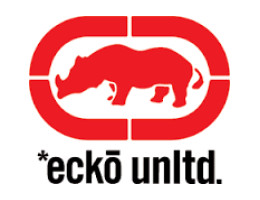







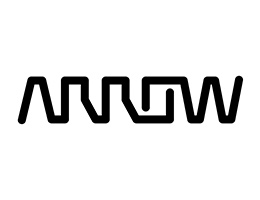

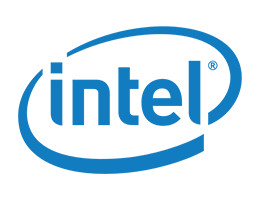



Programmers who care.
Magento Upgrades that won’t break your site.
Need help upgrading to Magento 2.0? Click Here >>
Magento 2.0 has launched! Nov 17, 2015 (Update)
After many years of development, Magento 2.0 has officially been released to the world!
Our team has been working on developing extensions, getting trained on the new system, and have spent hundreds of hours now learning how to best implement Magento 2.0. We’ve installed and tested both the Magento 2.0 Community and Enterprise editions, and so far we’re very impressed.
But given that Black Friday – the biggest shopping day of the year – is just a week away, Magento 2.0 won’t likely be used by any of the top eCommerce sites in 2015 for the busy holiday season (although a few merchants were using a Beta release and have been on Magento 2.0 for a few months).
But here’s why I think many sites will likely upgrade to Magento 2.0 next year:
- Full page caching (proactive, materialization) built in to both Magento 2.0 Community and Magento 2.0 Enterprise. I’ve talked about this quite a bit in the past, but what this means is that instead of your Web server having to do a tremendous amount of slow database queries to render a page, this system builds out all of your pages in a static file system, so that page load times are 1-2 seconds (vs. 5-10 for non-cached pages). This is a huge deal.
- Streamlined Checkout Process. Nearly 80% of current Magento eCommerce sites have modified their checkout process to better streamline the process. With the Magento 2.0 checkout, guest checkout is assumed, and if you’re an existing customer, you can still log out without having to remember your password. Pesky things like having to choose credit card type have been removed. (It’s easy for a computer to figure out your credit card type based on the first digit: 3 = Amex, 4 = Visa, 5 = MasterCard, etc.)
- A clean, modern code base. Magento 2.0 is a fresh start. Merchants who want to go with Magento 2.0 will know that legacy extensions or old, bad code will be removed. There’s no easy way to leave non-optimized code in place for Magento 2.0 sites.
- Better performance / reduced table locking. With larger scale Magento Enterprise and Magento Community sites, we’ve seen performance issues with table locking when too many people are trying to place orders on a site. For example, if you have 120 people trying to check out per minute, and you have queries that take 1 second to execute (and need to lock a table to write), then your system will crash. For example, before an order is saved in Magento 1.9, the system saves key information to a Sales Grid Flat Table, so that a Magento admin user is able to see the new order in the Magento admin. But in order to do this, it has to lock the table, and this can back up processes to where people have 45 second or more page load times. We’ve gotten around this specific issue with crazy levels of caching and very esoteric mySQL table optimization. But Magento 2.0 Community / Magento 2.0 Enterprise promises to have reduced this issue considerably.
And the top reasons I think that people will adopt Magento 2.0 Enterprise:
- Database is no longer a single point of failure. Magento 2.0 Enterprise allows you to separate your databases. You can have one mySQL database that is responsible for serving all of the content pages, product and category pages. You can scale this out with caching, and allow tens of thousands of people to hit these pages. But once someone adds something to the cart, you can separate this out to have the checkout process use a completely separate database. This allows you to have much, much better performance, and make sure that people who are trying to checkout won’t be slowed down by people just trying to browse (but not purchase). For bigger sites that do 5,000+ orders a day, this will make a big difference.
- All of the other key features of Magento Enterprise that are built in, including: RMA, Admin logging, gift registry, advanced customer segmentation, personalization, better PCI compliance, gift points and more. If you need these features, Magento Enterprise has them built in, and you don’t have to turn to third party modules.
Here’s why people may take a little bit of time to adopt Magento 2.0:
- If a Magento 1.9 or 1.14 merchant has advanced customization (i.e. inventory synchronization, custom modules, etc), then all of this will need to be re-built for Magento 2.0. Many of the top Magento extensions will be available soon. But if there’s a key extension that hasn’t been built yet, this might cause some people to wait.
- If someone just spent a lot of time and energy building out a Magento 1.9 or 1.14 system, then they may be hesitant to build out another whole site… especially if the one they have is running really quickly and is stable.
We’ve already started to get calls today about upgrading or migrating to Magento 2.0. All in all, we’re thrilled about the new platform and are looking forward to building out new Magento 2.0 sites soon.
Here’s Magento’s home page, announcing the new Magento 2.0 platform:
Here’s an email announcement, letting everyone know that Magento 2.0 is now “GA” (Generally Available):
Update on Magento 2.0 – October 2015
Our team has gone through extensive Magento 2.0 training. We’ve gone through both front-end and back-end certification courses from Magento, and have completed our Capstone Exercises for Magento 2.0. We’ve spent more than 100 hours of internal developer time working on new modules and functionality, and have new test servers just for Magento 2.0.
There’s no firm launch deadline, but we think it will likely be sometime in November 2015.
Key New Features for Magento 2.0:
- Full Page Caching for Community + Enterprise: I can confirm that Magento 2.0 has full page caching built-in to both the community and enterprise versions. Even better, Magento 2.0 has the ability to do proactive caching (also known as materialization) in production mode. This means your site will run crazy fast, if set up properly.
- Better checkout flow. Another amazing feature is the streamlined checkout process for Magento 2.0. It should avoid the confusing step of “Checkout as a Guest or Login to Your Account or Create New Account” options that just seemed to frustrate people.
- Plus lots, lots more.
Update on Magento 2.0 – July 2015
After quite a bit of waiting (years, really), Magento 2.0 is nearly ready for general release. Yeah!!
Timeline for Magento 2.0:
- Q4 2014: Developer Beta (basically a rough cut of the system, with a lot of things left to be done and coded out)
- Q1 2015: Developer Release Candidate (basically a buggy version of Magento 2.0)
- July 2015: Merchant Beta (a few sites will run Magento 2.0 as a test, with a lot of amazing support from Magento)
- November 2015: Merchant General Availability (GA) – Magento 2.0 is released to the world.
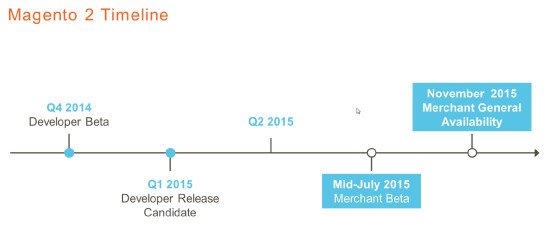
Magento 2.0 Timeline – View Larger Screenshot >>
Which means that most serious merchants will put off any serious Magento 2.0 implementation until 2016, because they don’t want to risk their site crashing due to a new technology during the most important shopping season of the year (November and December).
As of July 2015, Magento 2.0 community and Enterprise are still in Beta. I would not recommend running a live site on it yet, as there are a lot of bugs that will cause the site to crash. But it’s much, much closer to general availability release.
New updates on what Magento 2.0 offers:
- Full page caching on both Magento 2.0 Community and Magento Enterprise 2.0.
- This is one of the biggest things that I’m excited about. Full page caching is a game changer.
- It basically takes a database-driven site (where each page might have 100+ database calls to build a single page) and pre-renders all of the pages into basic HTML. This can take page load times down to 1-2 seconds, from a normal 5-8 seconds for many eCommerce sites.
- I’m thrilled that Magento has incorporated full page caching into the community version – this is just the built-in feature that will keep the open source community going.
- Faster page load times mean less load on a server. So you can handle more traffic and visitors without having to pay for more hosting infrastructure. Fast page load times make for a better end user experience, can translate into a higher conversion rate, and are a key signal that Google uses to rank sites (fast loading sites often will rank higher).
- Magento 2.0 is also compatible with Varnish 4, and the HHVM 3.6 (Hip Hop Virtual Machine), pioneered by Facebook to compile php code on the fly for even faster page load times.
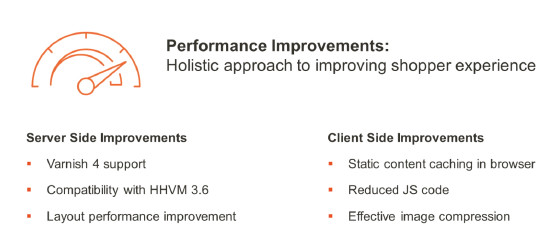
Magento 2.0 Performance Improvements – View Larger Screenshot >>
- Reduced JS code calls. In the past, Magento 1.9 and 1.14 needed to load dozens of javascript (JS) libraries to build a single page. This has been reduced; making page load times faster.
- Better APIs, more modular core, better theming and layout – all these are promised. We’ll see how this actually plays out though in the real world, however.
Database Improvements for Magento 2.0
For Magento, the single point of failure has always been the database. You can scale out front-end Web servers, place all of your content on CDN (content delivery networks), and use load balancing and failover to handle these items.
But until Magento 2.0, you were stuck with one single database to run the whole thing. Sure, you could back up the database to another server on a frequent basis. But everything runs in Magento out of a single mySQL database.
On Magento 2.0, you can have a standalone database for order management and checkout. This means that if you want, you can have the front end of your site’s content, products and categories served out of one mySQL database. And this database can handle a ton of traffic. But when someone wants to actually checkout on the site, the checkout page can use a secondary, standalone database. This allows you to scale out the site, and have a dedicated resources for the most important site visitors – the people trying to check out on the site and make a purchase.
Magento 2.0 also offers compatibility with mySQL clusters, and the catalog database separation.
Because of the database improvements, you can also have concurrent product management (up to 25+ users in the system updating products) and concurrent order management (up to 50+ users in the backend Magento admin processing orders).
Need help upgrading to Magento 2.0? Click Here >>
Speed Improvements in Magento 2.0:
Magento 2.0 is 25% faster for end users browsing the site (standard, out of the box installation), and 52% faster adding products to the cart than the current Magento 1.x platform.
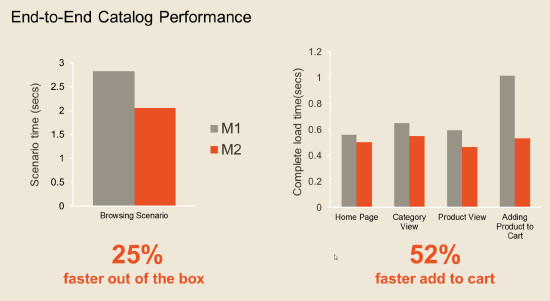
Speed Improvements of Magento 2.0 – View Larger Screenshot >>
With Magento 2.0, the system can easily support 10 million catalog page views per hour vs. just 500,000 page views per hour on the Magento 1.9 or Magento 1.14 platform. (Assuming the same hardware.)
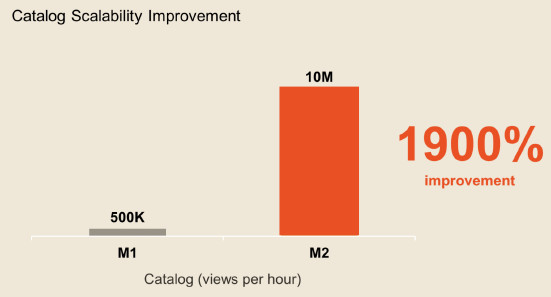
1900% Improvement in Speed for Catalog Views Per Hour – Click Here for Screenshot >>
Improved Checkout process in Magento 2.0:
I have to say… I’m impressed with the way in which Magento 2.0 optimizes and simplifies the checkout process.
The reality is that very, very few people ever want to “Create an Account” to checkout on most sites. Usually, people are forced to. And then when they want to checkout again they can’t… because they don’t remember their password.
There have been many One Page simplified checkout extensions for Magento over the years, and many of them have actually made the checkout process worse (because of errors during the shipping or payment process portion).
Instead, Magento 2.0 re-imagines the checkout process, and starts the entire process with the assumption that someone wants to checkout and make a purchase:
Magento 2.0 – Simplified Checkout Process – Click Here for Screenshot >>
The end user starts by entering in their email address into the system. If it’s found (because they are a past customer), then they will be prompted for their password (optional, but so the form fields can be pre-filled).
Otherwise, the end user just checks out normally.
The Zip code has moved ahead of the City and State fields (at least for the US example), so that City and State can be pre-populated based on the Zip code. This also allows the end customer to have accurate shipping rates calculate automatically, too, without having to do another javascript reload.
If your customer happens to live in a place where the Zip code has multiple cities (I lived in such a place in a small mountain town in the past), the end user can correct this:
Zip Code – Pre-fills in Shipping Method, City, State on Magento 2.0 – Click Here for Screenshot >>
My favorite option, though, was the removal of the “Credit Card Type” field:
Quicker Checkout Process with Magento 2.0 – Click Here for Screenshot >>
If you’ve been in the world of credit cards for a while, you know that anything that starts with a 3 is Amex, 4 is Visa, and 5 is MasterCard. I think that Discover Cards start with a 6 or an eight, but I honestly don’t know the last time someone tried to pay with Discover or a Diner’s Club Card.
Asking for the Credit Card Type was unnecessary – the system should be able to select the card type based on the credit card number. This is something that a lot of top sites have figured out – that the less information you ask for on a checkout page, the more likely people are to check out.
Finally, on the order success page – the page after you’ve placed your order… you’re now able to create an account so that you can come back to the site and track your order:
Create Account on Order Success Page – Magento 2.0 – Click Here for Screenshot >>
Magento treats guest checkout users differently than people who create an account. In the past, if you checked out as a guest, there was not easy way to subsequently “Save” your information as a customer account.
And you can do this with one single click. And do so at a time when it makes sense to end users (so they can come back and see if their order has been shipped.) This is a great feature and will convert a lot of guest checkout users into actual customer accounts.
Need help upgrading to Magento 2.0? Click Here >>
Improved Backend Magento Processes in Magento 2.0:
In the Magento 2.0 update, they also spent a lot of time focusing on how Website owners, who have to process orders and add / edit / remove products in the Magento admin have to work.
One of the most common requested features in the past was the ability to customize the Magento admin grid.
Magento 2.0 – Create Customized Admin Grid Per User – Click Here for Screenshot >>
For example, wouldn’t it be wonderful to add a few columns to the product grid so that it’s easy to sort?
In the past, this has required a custom module / custom coding to do this. But it’s now built in to Magento 2.0, and can be set and saved and personalized, based on each Magento admin user.
Second, you can now create a grid view in the admin area (such as Page Titles, SKU and Inventory levels), and then edit the information right on the page in the grid. Sort of like you can do on an Excel spreadsheet. This will save a ton of time, as opposed to the standard method of having to open up each product, navigate to a sub-tab, and then jump back into the grid when you save.
Magento 2.0 doesn’t really address a key issue with Magento products in general: Magento was primarily designed for a person, sitting at a screen, to enter in products into the admin area, one product at a time.
For a site that has hundreds of products, that’s not a big deal. For a site with tens of thousands of products (or more), bulk upload is really the only option.
But for Magento 2.0, they’ve added these features into the Magento 2.0 admin area:
- Bulk images for products. Basically, you can apply unique images by attribute to each SKU, or apply a single set of images to all SKUs.
- Bulk Pricing. You can apply pricing to a single set of images, or in bulk to all.
- Create Product Configurations. In Magento 2.0, you can use more of a visual editor to create attribute values, including checkboxes, that make it a lot easier to figure out for the average Magento admin user.
Magento 2.0 Admin – Bulk Image Add On System – Click Here for Screenshot >>
Magento 2.0 – Payment Gateway Update:
Magento 2.0 allows you to have a few improvements to the payment process, including:
- Third Party embedded APIs with direct post.
- An inline iFrame that allows a payment form to be hosted by a third party (i.e. Merchant processor), but still be embedded in the checkout process. I know of many clients who would love this option, because having the credit card payment page area hosted elsewhere mitigates the risk of credit card data being saved / hacked / stolen from a site. (And yes, sadly, this can happen even to Magento sites if you leave your server vulnerable.)
- Or, you can have a third-party hosted payment page (such as PayPal) that redirects the end user to a page on a completely different domain.
Magento 2.0 is tightly integrated with PayPal, BrainTree, CyberSource, Authorize.net and WorldPay, among others.

Magento 2.0 Embedded Payment Methods – Click Here for Screenshot >>
What’s next after Magento 2.0 is released?
On the post-launch feature list are:
- Extended API coverage
- Staging and preview functionality for Magento sites (something that isn’t always possible on a live Magento site).
- New search functionality (because this can always be improved)
- Improved CMS (perhaps to make it easier to work with a.k.a. WordPress CMS)
- Multi-warehouse support (Magento does not natively allow you to keep track of items in multiple warehouses)
Migrating from Magento 1.9 Community to Magento 2.0?
Magento has promised a data migration tool that will allow product, order, and customer data to be migrated. The data migration tool will also help move CMS pages, store configurations, EAV tables, promotions, Customer passwords and URL rewrites.
Extensions will need to be completely re-built (or re-downloaded from the Magento Connect marketplace), as will design themes and customizations to the Magento framework.
If your site has a ton of core file modifications or crazy extensions, it won’t be as straightforward, though.
Need help upgrading to Magento 2.0? Click Here >>
Updates from the Magento Imagine 2014 Conference on Magento 2.0:
At the 2014 Magento Imagine Conference, we found out that Magento 2.0 is on a fast-track to be released to the public early next year.
My estimate is that it will be released as a public Beta in December, and the Magento 2.0 code base will be released to the public in time for the 2015 Magento Imagine Conference.
It also appears that Magento 2.0 is going to include full page caching in the Community Platform. This is a HUGE deal, and should greatly speed up page load times for Community sites. In the past, Full Page Caching has only been a feature on the Magento Enterprise system, and has been one of the key reasons that many store owners have upgraded. The Enterprise version of the code base promises better scalability, but including Full Page Caching in the Community version of Magento 2.0 is going to make a big difference for store owners, search rankings and help with the future adoption of the platform.
Magento 2.0 – a complete revamp of the Magento code base – has been under development for quite some time. We’ve been testing the Alpha version at our office, and we’re excited to learn that Magento has stepped up their development efforts.
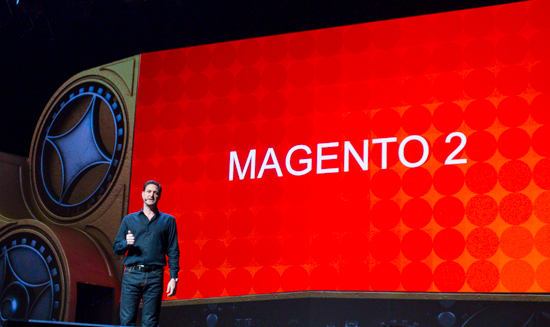
Magento’s Mark Lavelle, Senior Vice President, discussed the roadmap for Magento 2, and it’s a complete overhaul of the Magento code base to bring it up to more modern standards.
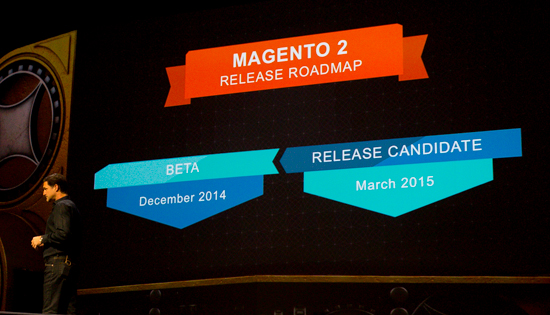
The Beta Release will be out in December 2014; the Release Candidate will be available in March 2015.
Which (in my opinion, not based on anything from Magento), pretty much sets up Magento 2.0 for a release at the next Magento Imagine show, next May 2015:
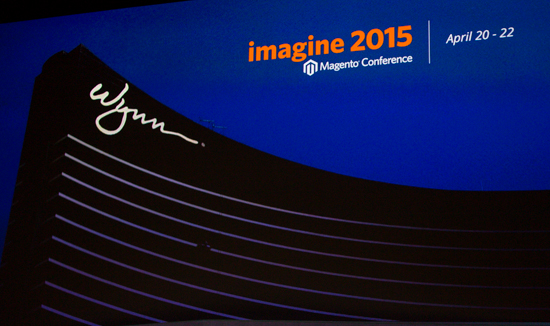
Why Magento 2?
Why Magento 2?
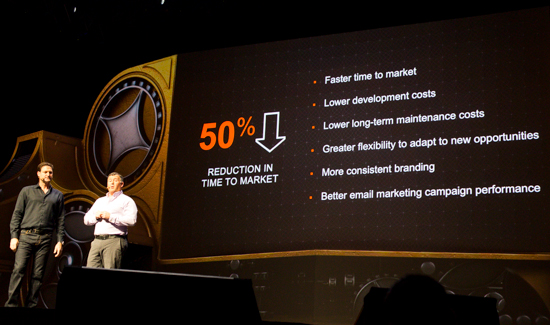
Paul Boisvert, Director of Product Management for Magento, discussed how Magento 2.0 will allow faster time to market, with lower development costs.
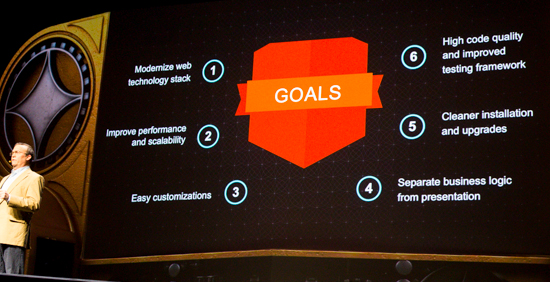
Why revamp the code base for Magento 2?
It brings in a much more modern code base to the picture. The current code base was designed and architected in 2006 / 2007 – eons in the Web world.
Magento 2 allows for cleaner installation and upgrades, and better performance and scalability.
Magento has been using an agile process, and has made 30+ Github pushes to the Magento 2 code base since October of last year:
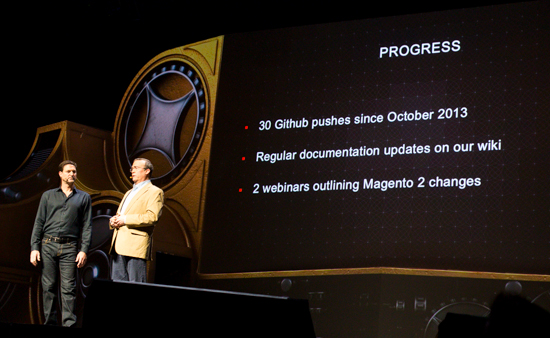
What is Magento 2.0?
The Magento commerce shopping cart system was developed by Roy Rubin and his team as a response to OS Commerce. OS Commerce was an early, open-source eCommerce system.
At the time, Rubin was running a Web design company, and was frustrated with how difficult it was to implement design, and not be able to upgrade easily. OS Commerce didn’t have a framework for extensions and plugins (like WordPress and now Magento do), so Magento was born.
Magento now has over 110,000 255,000 (updated for 2014) eCommerce store fronts that use the Magento Community or Enterprise platform. It’s feature rich, and contains nearly everything a marketer needs. It’s very stable, and set up properly, can run very fast.
More than five years later, Magento 2.0 is an overhaul of the Magento code base, and includes a visual editor, new “containers” for handling visual elements on a site, better overall performance and more.
The Magento 2.0 codebase is now publicly available at GitHub, and if you’re a developer, you can download the code, test it out, and create a branch.
Free, No Obligation Consultation About Magento Upgrade to 2.0:
| Call Today! 303.473.4400 | Or Click Here To Have A Real Person Contact You Now >> |
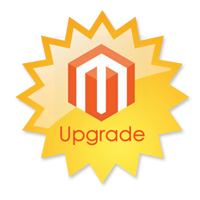 Upgrading to Magento 2.0
Upgrading to Magento 2.0
If you’re considering upgrading to Magento 2.0 when it is released (probably in 2013 – Update: Best Guess – April 2015), we highly recommend doing a Magento code audit on your Website, to determine what functionality might not work if you migrate to Magento 2.0.
Although Magento 2.0 has not yet been released, we’re beginning the process of testing the upgrade platform.
Between now and when Magento 2.0 is released might be a good time to make sure your site is upgraded to the most recent version (i.e. upgrade to Magento 1.9), and is free from security vulnerabilities and core code changes.
Magento 2 Overview:
In April 2012, the Magento team showed a demo of Magento 2.0 at the Magento Imagine conference in Las Vegas, Nevada. On October 31, 2012, the Magento team had a conference call for developers, where even more specific information about Magento 2 was discussed.
Key features of Magento 2:
Magento 2 will include new features like the Visual Layout Editor, that makes it much easier to drag-and-drop blocks of text or images on pages. This will be a welcome change to the somewhat difficult process of working within layers of template files.
If you are planning on upgrading your Magento site from versions 1.5, 1.6, or 1.7, there are some important considerations to take into account, because Magento 2.0 will not be completely backwards compatible.
For example, Magento 2:
- Removes some payment methods
- Slims down by 20% the config.xml file
- Adds the “container” to the layout options, in addition to Magento’s “blocks”:
- Containers can contain blocks.
- Containers can contain other containers.
- Containers are part of the visual design editor, that allow you to move blocks around.
- Magento 2 eliminates skins, and instead uses themes. This removes the packages from the entire Magento file system.
- Magento 2 allows you to manage design themes and packages via the database (vs. uploading files).
- How cookies are handled, as well as session information.
- Magento 2 migrates to jQuery, which wasn’t robust enough when Magento first started, but now is an industry standard.
- Magento 2 relies on REST API and SOAP with WSI compliance.
- Magento 2.0 will use the Zend Framework 2 for performance issues including a cache engine, translations and the database access layer.
Magento 2.0 User Experience:
From a user experience, Magento 2 updates these areas:
- Menu system and navigation
- Access control (how users are able to log into the system)
- Adding a new product to the system should be faster / quicker / easier. In the past this can be too time consuming for many Magento storefront owners.
- How taxes are handled through the system
Magento 2.0 Allows For Other Databases:
Magento 2.0 will support the use of Microsoft SQL server databases, Oracle, and some other databases as well (as well as mySQL).
Magento 2.0 Automated Testing:
Magento 2.0 is expected allow Magento store owners the ability to set up automated tests for Unit Testing, Integration, Functional and Performance testing. This is something that previously required a separate testing system or a staff of dedicated testing people to accomplish.
Magento 2.0 Migration Tools:
Magento will be releasing migration tools to help with the data and code conversion from Magento versions 1.x to Magento 2.0, but as has been the case in the past, this might not work for everyone.
Magento 2.0 should also increase the performance and scalability of the previous versions of Magento. While Magento is a feature-rich system, if it isn’t configured properly, it can be slow to run without the right hardware and caching management systems in place.
Magento 2.0 promises:
- Better optimized database access for the system.
- A new re-indexing operation, that allows you to decrease the reliance on database lookups
- Code improvements that will streamline performance
Free, No Obligation Consultation About Magento Upgrade to 2.0:
| Call Today! 303.473.4400 | Or Click Here To Have A Real Person Contact You Now >> |
Want to Upgrade to Magento 2.0?
Essentially, a Magento upgrade is a three step process:
1. First, we update your database and file structure system to point to the new version of Magento.
2. Second, we move over the themes and custom extensions that make your site unique.
3. Third, we set our Testing Team on the upgraded development site to ensure everything functions properly.
Once the site has been approved by our Testing Team and the client we go ahead and put the upgraded site live.
We have a stellar track record for successful upgrades on Magento eCommerce sites.
Unlike our competitors, we don’t simply execute the command and then dump the incomplete project back in your lap.
Customer Paradigm has used Magento eCommerce, PHP programming and mySQL databases to help small 1-person companies as well as many of the Fortune 500 create websites that get results.
Try us out! Get your first hour of Magento programming for Free (when you commit to a five hour or longer project). To have Customer Paradigm contact you about a Magento upgrade for your site, please fill out the contact form here or call us at 303.473.4400.
Some of Customer Paradigm’s Work:
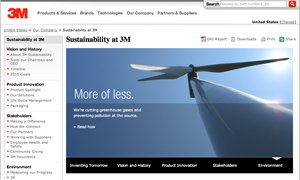 |
3M Sustainability Site Website for 3M’s Sustainability Department, aligned with 3M’s corporate Web standards. View Larger Image >> |
 |
Energy Classroom by Xcel Energy Microsite for Xcel Energy, the 4th largest power company in the United States, teaching energy conservation for teachers, students and other constituencies. View Larger Image >> |
 |
Travelocity Accessories Shop by Mizco Travelocity is a leader in online travel and for the last sixteen years has guided travelers to affordable and convenient flights, hotels, vacation packages cruises and car rentals.. Their partner, Mizco International, Inc. (“we”, “us”) came to Customer Paradigm wanting to create a eCommerce travel accessory shop with full functionality from search features to payment methods. The site, which is owned and operated by Mizco under license from Travelocity, LLC (“Travelocity”) continues to provide thousands of savings to travelers all over the world. View Larger Image >> |
 |
AAMCO Colorado Search Engine Optimization, Cost Per Click Marketing, Website Development for all Colorado-based AAMCO dealers to drive targeted leads for auto repair. View Larger Image >> |
 |
Up With People Website development for Up With People, a global education organization that aims to bring the world together through service and music. View Larger Image >> |
 |
Citrix Mobile Website development, Trade Show Marketing for leading company in GoToMeeting – Web Conferencing space. View Larger Image >> |
 |
San Francisco Soup Company Website Development, Mobile Application System, Daily Soup Email Marketing System for San Francisco-based fast casual restaurant. View Larger Image >> |
 |
Fresh Produce Clothing Magento Enterprise eCommerce Development, Custom Application Development for clothing retailer, using the Magento Commerce platform. View Larger Image >> |
| San Francisco Main Freight Custom Application Development for world-wide logistics company. Customer Paradigm has built a system that tracks more than $100 million of products, including where items are located in each warehouse and when items are shipped, returned or damaged. |
|
 |
Warner Music Group Magento Enterprise Commerce development for custom extension for Warner Music Group Websites. View Larger Image >> |
 |
Adventure Rabbi Website Development, Photography, Online Marketing for outdoor religious organization. SEO efforts led to coverage by CNN, NY Times, Wall Street Journal, CBS News and more. View Larger Image >> |
 |
Red Apple Lipstick Magento Website development and programming for leading retailer of gluten-free lipstick and cosmetic products, using Magento Community edition. View Larger Image >> |
Other Magento Services:
- Magento Developers
Improve your rankings in Google, Yahoo, Bing, and other search engines and drive more traffic to your WordPress website. . . . learn more - Magento Upgrades
New features, security updates and peace of mind are all excellent reasons to upgrade your current Magento installation. . . . learn more - User-Friendly Magento Design
We provide a wide range of design services from making banner advertisements to completely redesigning entire websites. . . .
learn more - Immediate Magento Support
We offer a variety of services and solutions for Magento stores big and small to ensure that your site stays up and running. . . . learn more
h2>More On Internet Marketing with Customer Paradigm
What are some of the things we do to help you get better rankings, more traffic, and more sales?
We would love to talk to you about your online marketing goals. Please give us a call at 303-473-4400 or contact us to speak with a real person now.
About Customer Paradigm
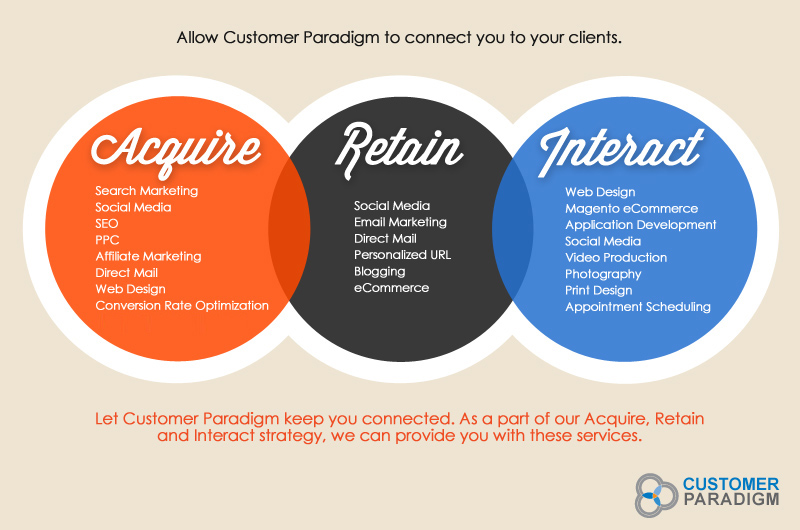
Customer Paradigm is a full-service interactive
media firm, helping businesses acquire, retain and
interact with our customers.
We specialize in Magento Developers. Our team of Magento Developers know Magento inside and out. Customer Paradigm has clients throughout the United States, Canada, Europe and Asia. Our customer-centric approach allows us to internalize our client’s vision for their organization and design websites and print marketing that gets results.
Our Magento Developers also work closely with our team members who focus on search engine optimization (SEO), search engine advertising (CPC) and Conversion Rate Optimization (CRO). Our open-office, team-approach makes sure that we take an integrated approach to your project. Nobody is programming in the dark… we’re always looking out for other factors including how the customization will affect SEO, social media and CPC campaigns.
Our work includes Website development for 3M, microsites for Xcel Energy and marketing campaigns for the Four Seasons, BP, Shell Global Solutions and Genetech.
From continuing medical education courses and e-newsletters for Johns’ Hopkins University, to trade show marketing / mini-CRM systems for Genetech, to secure remote imaging software and website development for the Greeley Medical center, we understand the specific challenges and opportunities faced by a wide variety of industries.
We’ve done privacy consulting work for Merck, McGraw Hill, Lillian Vernon, and Starwood Hotels. We understand the challenges a regulated industry faces when it comes to the collection, use, storage and access to sensitive, personally-identifiable information on their websites across the U.S. and abroad.
We’ve built eCommerce systems for Travelocity, helped AAMCO Colorado achieve top search engine optimization results, and created microsites for Go To Meeting’s Citrix. Clothing retailer Fresh Produce relies on Customer Paradigm for custom Magento eCommerce programming. The San Francisco Soup Company leverages Customer Paradigm’s cross platform expertise in an integrated mobile optimized system and daily email marketing campaigns.
Our Search Engine Optimization (SEO) efforts helped news organizations find local religious leader, Rabbi Jamie Korngold and cover her program in The Wall Street Journal, USA Today, AP, Ski Magazine, CBS News and more. This intense media interest sparked a book offer from Doubleday Religion, who published Rabbi Korngold’s first best-selling book, God in the Wilderness (www.GodintheWilderness.com).
In the sustainability realm, Pfizer, 3M and Intel are the first users of a manufacturer-based sustainable development software planning tool we’ve developed for the Global Environmental Management Initiative (GEMI) organization. We’ve also recently redesigned the sustainability section of the 3M Website site for 3M.
Customer Paradigm was named the 2009 Supplier of the Year Rocky Mountain Direct Marketing Association. Customer Paradigm’s founder, Jeff Finkelstein, has been called a “Web Guru” by New York Times Magazine.
Since 2002, we’ve completed more than 12,600+
successful projects for our customers.
Magento certified developers who care.
Code that works.
Call now – 303.473.4400

